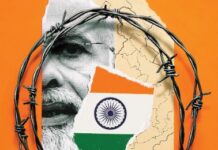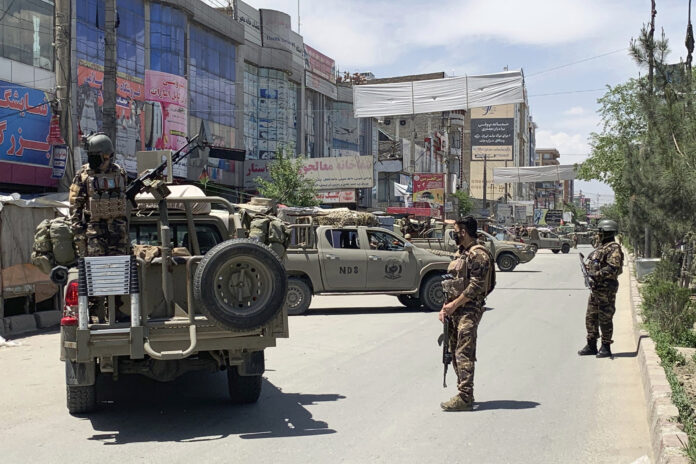The Great Game in Afghanistan is in the final phase, with 95 percent of the US troops withdrawal completed, and the Taliban are pushing the Kabul regime into the corner. The recent dramatic military victories pose a serious security threat to the Kabul regime.
The regime in Kabul has been left with multiple security problems at hand. Starting from a decrease in troops recruitment to a massive surrender of ANA. Despite the ANA still a force of 250,000 soldiers it lacks the military hardware, training, and professionalism. Moreover, compatibility, integration, an repairing of military hardware, is another major issue for the ANA. With all these problems chasing it, it is being tasked to deal with the immediate crisis, which is the advance of the Taliban. The Taliban have already managed to take over all major border crossings with all immediate neighbours, including Iran, Tajikistan, China, and Pakistan, cutting the land connectivity of the Kabul regime with regional players. These ports and crossing are operational and the Taliban are generating revenue from them.
Meanwhile the ANA is unable to recapture even one of them. They are putting themselves in a difficult situation because the Taliban are generating revenue from these border points, which would be enough to support, expand and sustain military operations across Afghanistan. The failure to recapture these strategic locations indicates a lack of will as well as a lack of strategy to deal with the powerful insurgency across Afghanistan.
In fact in most of the cities and towns Taliban took over without any considerable resistance, while in others, ANA troops surrendered after a few clashes. The amnesty announced by the Taliban is another major factor. Both sides had enough of this war, now they want peace and stability, but can the Kabul regime deliver on the table when it is not performing on the battlefield?
The majority of ANA grounded aircraft and helicopters are of the Soviet era, so with the sanctions in place, the Kabul regime is not able to collaborate with Russians to repair and maintain those. New Delhi, which operates many Russian aircraft and attack helicopters, including Mi-17 and Mi-35, can be the place for Kabul to turn to.
Talking about the will and strategy in most of the locations ANA forces surrendered because the headquarters were unable to send reinforcements. This is concerning for Kabul apparently it seems like the ANA lacks the ability to sustain the battlefield for long. Winter season is around the corner in which battles would be much longer.
But is the Kabul regime a sitting duck? All regional and non-regional players are closely monitoring the building crisis and changing dynamics of the conflict. Many are already shifting policies and are adjusting to the building situation. Even though all regional countries have buffed up border forces. meanwhile, including Tajikistan and Iran, they have already started official engagement with the Taliban especially after they took over border crossings. All these parties are trying to develop working relationships especially in the context of trade and transit.
For the Kabul regime, political legitimacy is linked with dominance in the battlefield, where the Kabul regime is not performing well. For the operations and counter-insurgency drive the ANA was heavily relying on US close air support. Post-Withdrawal the Pentagon has refused to offer direct military support and would only be providing financial and military aid.
The problem doesn’t end here; ANA has limited options regarding the military hardware. ANA does not have enough time and resources to purchase new aircraft and attack helicopters, it can be a long-term modernization project but for now, the ANA needs rapid modernization with a new conclusive strategy. The security challenge is immediate.
The majority of ANA grounded aircraft and helicopters are of the Soviet era, so with the sanctions in place, the Kabul regime is not able to collaborate with Russians to repair and maintain those. New Delhi, which operates many Russian aircraft and attack helicopters, including Mi-17 and Mi-35, can be the place for Kabul to turn to.
But the USA does not offer funding or advisory support for this project and in fact is pursuing Kabul to give up on all of those. The repairing and operationalization of 11 grounded Mi-35s will cost around $50 million. Over the years Delhi has assisted ANA, even has provided helicopters. During the last week two Globe master C130 of the India air force delivered consignments to ANA, the consignment included 122mm artillery cannons with other tonnes of ammunition.
But regardless of the debate whether Delhi is willing to invest $50 million for Mi-35 helicopters or not, the project seems unlikely to make any progress because just last month MD helicopters secured a contract of around $43 million related to Afghanistan air force 530F light attack helicopters. ANA has around 75 530F’s but with this deal, The USA has likely offered an alternative to the project of Mi-35s whose cost is almost the same. But would it be enough to turn the tables? Time will tell but with the security situation getting worse the security options for Kabul are also squeezing. Kabul regime now has to revisit the security policy and have to play within these limited security options.























